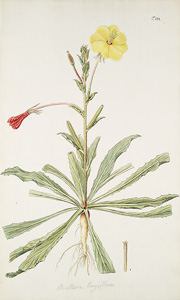Evasive Evening Primrose
By Audrey Stallsmith

When once the sun sinks in the west,
And dew drops pearl the evening’s breast;
Almost as pale as moonbeams are,
Or its companionable star,
The Evening Primrose opes anew
Its delicate blossoms to the dew;
And hermit-like, shunning the light
Wastes its fair bloom upon the night. . .
“Evening Primrose” by John Clare
Many types of evening primrose do, indeed, waste their blooms upon the night. They pop open around suppertime, sometimes--if YouTube videos can be believed--taking only a couple minutes do so and with an audible sound. Keats writes of being “ever startled by the leap of buds into ripe flowers.” Those flowers then close before the lunch hour the following day, but may stay open on dim afternoons.
Some people claim the four-petal blooms actually glow in the dark, and they are called night candles in Germany. If true, that fluorescence should more than make up for their reticence during the day.
Also, some types of “tree primroses” remain open during the sunlit hours as well and are even known as sundrops, due to their most common yellow hue. Even that isn’t consistent as they come in pink and white as well, and I also grew an exquisite tiny-bloomed type called 'Blood Orange' whose fiery color did not at all resemble Barton’s “pallid flowers, by dew and moonlight fed.”
The plants can be annuals, biennials, or perennials, varying in height from 4 inches to 6 feet and in diameter of blooms from 1 to 4 inches. You can see why they sometimes stand for “inconstancy” in The Language of Flowers.
Frequently pollinated by moths, the plant often harbors a few as well. Squat buds which never open sometimes enclose "worms" which will turn into nighttime fliers such as Schinia florida, the pink, yellow, and white “primrose moth.”
The flower’s Latin name Oenothera derives from oinos (“wine”) and thera (“hunt” or “catch”), due to its dried roots supposedly catching the scent of wine. All parts of the plant are edible, so it’s possible those parsnip-like roots were once served with wine as well.
Native to the Americas, the evening primroses were quickly snatched up by plant explorers and carried to the Old World, self-seeding freely enough to become wildflowers there as well. They bloom most heavily in early summer, though some can continue to perform for the remainder of the warm months.
They are most famous these days for the oil extracted from their seeds. Rich in gamma-lineolic acid, that oil has been recommended for the prevention or treatment of a wide variety of conditions including eczema, heart problems, MS, and Parkinson’s disease.
So, if the evening primrose prefers to hide its candle under the darkness of night instead of under a bushel, we should still be grateful for its glow!
Oenothera longiflora Image is from Horto Botanico Vindobonensi by Nicolai Josephi Jacquin, courtesy of the Missouri Botanical Garden.








